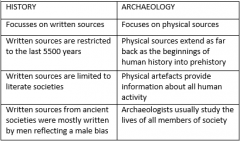![]()
![]()
![]()
Use LEFT and RIGHT arrow keys to navigate between flashcards;
Use UP and DOWN arrow keys to flip the card;
H to show hint;
A reads text to speech;
20 Cards in this Set
- Front
- Back
|
What is history? |
History is the study of past events, particularly in human affairs. A huge and controversial subject so it is impossible to give one definition. |
|
|
What is archaeology? |
The study of history through excavation of site and the analysis of artefacts and other physical remains. |
|
|
What do historians do? |
Historians have an ongoing discussion with the past through what is discovered and their theories. They find what the believe to have happened in the past. |
|
|
Main differences between history and archaeology? |

|
|
|
What are the two main types of dating used? |
Relative dating and absolute dating. |
|
|
Stratigraphic Dating |
Dating the different levels of strata. |
|
|
Typology Dating |
Organising finds in chronological order. (pottery, tools and weapons work best) |
|
|
Seriation Dating |
Arranged into typology sequence then grouped with similar artefacts. |
|
|
The three-age system |
Stone - Bronze - Iron - Ordering artefacts by these materials |
|
|
Absolute dating |
A dating method that is morel likely to be correct |
|
|
Radiocarbon Dating |
Date materials between 50 000 and 400 years old. Dates the decaying carbon levels. |
|
|
AMS Radiocaron Dating |
Improved version of radiocarbon dating that can date back to 70 000 years. Needs much smaller samples, results produced quicker. |
|
|
Dendrochronology |
Tree ring dating, a tree's (or wooden object's) age can be determined by the growth rings. |
|
|
Potassium-Argon Dating |
Dates volcano rocks up to millions of years old. One of the most useful methods in high volcanic activity areas. |
|
|
Uranium-series Dating |
Date rocks containing calcium carbonate that are mostly found in caves. Good for dating human evolution as caves are a big part of prehistoric humans lives. Can date between 50 000 - 500 000 years, more than AMS Radiocarbon Dating. |
|
|
Fission-track Dating |
Determine the thermal age of artefacts containing uranium-bearing minerals. Dates between twenty and one thousand million years. Glass, stones used in heaths and any fired ceramics are able to be dated with this method. often used to verify dates gained from Potassium-Argon dating. |
|
|
Thermoluminesence |
Radioactive dating. Can date pottery and inorganic material that is over 50 000 years old. Often used when radiocarbon won't work. Fake artefacts can have the authenticity tested. |
|
|
Stratigraphic analysis |
Page 13 in the textbook. |
|
|
Heinrich Schleinman |
Found the site of Troy but used horrible practices to ruin the site, trying to discover the right layer, but he actually destroyed the actually layer of Troy. |
|
|
Ethical Issues |
If something is found somewhere should it stay there. Bodies discovered, should they be given back to families or kept for history. |

